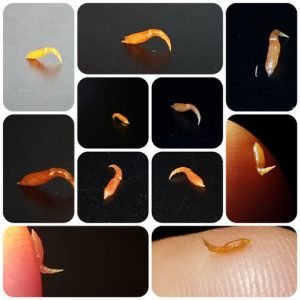
So, what are wolf worms? They’re actually the larvae of a type of fly known as *Cuterebra*. These pesky little critters can burrow into the skin of squirrels, causing a variety of symptoms that indicate something isn’t quite right. As you sip your coffee, let’s dive into how to recognize the signs of wolf worms in squirrels and what you can do to help manage this condition effectively.
What Are Wolf Worms?
Wolf worms, or Cuterebra larvae, are a fascinating yet troubling part of some squirrels’ lives. When a female Cuterebra fly lays her eggs, the larvae hatch and can latch onto a squirrel if it comes into contact with the eggs. Once they attach themselves, they burrow under the squirrel’s skin, creating a little home for themselves. This may sound like something straight out of a horror movie, but it’s a natural part of the life cycle of these flies.
You might be wondering how common wolf worms are. In the wild, their incidence varies by location and season. They tend to appear more frequently in warm months, especially in areas where many squirrels are active. Imagine a picnic on a sunny day: the flies are buzzing, and so are the squirrels. That’s when the risk of infection starts to rise.
Identifying Symptoms of Wolf Worm Infestation
Recognizing the symptoms of wolf worms is crucial for the health of squirrels. It’s often the case that a squirrel might look a bit off before you realize it’s due to these irritating larvae. Here are some common signs to look for:
- Swelling: One of the first signs is a noticeable swelling on the squirrel’s body, particularly near the head, neck, or back. It might feel soft to the touch.
- Foul Smell: As the larvae grow, they can cause an infection, leading to a distinct, unpleasant odor. This should raise immediate concern.
- Difficulty Eating: If a squirrel is dealing with pain or discomfort, it might not eat as much as normal.
- Behavior Changes: Watch for lethargy or reduced activity. A previously active squirrel might seem uninterested in exploring.
If you spot any of these symptoms in a squirrel, it’s time to take action. Understanding what to look for is your first step in helping them recover.
Why Do Wolf Worms Infest Squirrels?
You might be curious why squirrels become hosts for wolf worms in the first place. The main factor is exposure to the eggs laid by the Cuterebra fly. These flies are often found in areas where squirrels live, particularly in grassy or wooded environments where they can lay their eggs.
Imagine the life of a fly: it’s all about survival and reproduction. The fly’s eggs need a host to thrive, and squirrels just happen to be the perfect target. When the squirrel brushes against the eggs, they can stick to its fur and then get transferred to its skin. It’s nature’s way of perpetuating the cycle, even though it’s not great for the squirrels involved.
It’s also important to note that young squirrels are more vulnerable, as their immune systems are still developing. So, if you see a young one looking a bit off, it could be more than just typical playfulness.
How to Manage Wolf Worm Infestations
If you suspect a squirrel has a wolf worm infestation, it’s crucial to act quickly. Here’s a step-by-step approach to managing the situation:
1. **Consult a Veterinarian:** The best first step is to reach out to a vet who specializes in wildlife. They can confirm the infestation and guide you on the next steps.
2. **Treatment Options:** Treatment may involve removing the larvae surgically or administrating medication to help clear the infection. The vet will have the expertise to choose the right method.
3. **Post-Treatment Care:** After treatment, keep an eye on the squirrel’s recovery. Provide a safe space where it can rest and heal without stress.
4. **Prevent Future Infestations:** Ensure that your backyard or surrounding area is less hospitable to flies. This means keeping outdoor spaces clean and minimizing debris where flies may breed.
By following these steps, you can help ensure a squirrel makes a full recovery and reduce the risk of future infestations.
Wolf worms may seem daunting, but with the right knowledge and actions, you can help protect and manage the health of squirrels in your area. Keeping a watchful eye for symptoms, understanding the reasons behind infestations, and knowing how to manage the situation can make a significant difference.
Remember, these little creatures play an essential role in our ecosystems, and caring for them is a rewarding endeavor. Just like all animals, squirrels deserve our compassion and attention, especially when they encounter health issues like wolf worms. So, next time you spot a squirrel in your yard, think of the ways you can support their well-being—even if that means helping them through a tough time with a little knowledge and a lot of heart.
